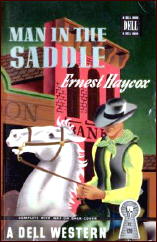Fri 19 Feb 2010
A Western Review by Dan Stumpf: ERNEST HAYCOX – Man in the Saddle (Book and Film).
Posted by Steve under Reviews , Western Fiction , Western movies[3] Comments

MAN IN THE SADDLE. Columbia, 1951. Randolph Scott, Joan Leslie, Ellen Drew, Alexander Knox, Richard Rober, John Russell, Guinn ‘Big Boy’ Williams. Screenplay: Kenneth Gamet, based on the novel by Ernest Haycox. Director: Andre de Toth.
ERNEST HAYCOX – Man in the Saddle. Little Brown, hardcover, 1938. Reprinted many times, in both hardcover and soft, including Dell #120, pb, mapback edition, 1946 (shown); Dell #618, pb, 1956; Signet, pb, 1972; Pinnacle, pb, 1988.
Four years after Ramrod (reviewed here ), director Andre de Toth did it again. Columbia’s Man in the Saddle (1951) is based very closely on the 1938 book of the same name by Ernest Haycox, but it seems more like a re-telling of the earlier film, and equally noirish despite the Technicolor.
This time, Joan Leslie is the woman looking to escape a shiftless father by marrying a cattle baron (played with chilling detachment by Alexander Knox) though everyone knows she loves small-rancher Randolph Scott, a circumstance that leads to Range War and the shoot-outs, bar-fights, stampedes, chases, et al. repeated from the earlier film.

Haycox’s novel is an easy read, even if his prose lacks the punch of Luke Short’s and he really doesn’t invest the action scenes with much energy. He’s very good, though, at conveying the growing tension of an eminent shoot-out, or the suspense of a forthcoming ambush, and in these bits the book really comes alive.
Writer Kenneth Gamet adapted this to the screen, and he managed a few interesting wrinkles while staying close to the book, streamlining the action and bringing some of the minor characters into better focus, particularly John Russell as a socially-challenged outcast, contrasted against Richard Rober as a genial killer.
There’s also an interesting twist at the end as two antagonists resolve their conflict, only to find themselves trapped in their clichéd roles as Good Guy and Bad Guy. In all, an interesting variation on the earlier film, and fun all by itself.
Someone also pointed out another common theme in these films: both Ramrod and this one, they say, carry sexual connotations. Being young and innocent, I wouldn’t know about that, but it’s an interesting thought.
February 19th, 2010 at 11:07 pm
Haycox is a more novelistic writer then Short, and in his day one of the best known and respected names in the western genre. And Dan is absolutely right in regard to Haycox vs Short.
Short is certainly punchier and more visceral while Haycox is more novelistic and goes a bit deeper into character.
And since it has to be said, Haycox, of course wrote “The Last Stage to Lordsburg” a western tale suggested by de Maupassant’s “Boule de Suif” that became John Ford’s STAGECOACH.
This one is a good film too, though I don’t know if I would have had Dan’s nerve to go to the Freudian interpretation of the films titles.
It is also notable that these two deeply plotted noirish westerns are based on novels rather than original screenplays. In different ways both Haycox and Short belonged to a newer style of the western that had a bit more in common with the Hemingway school than Zane Gray, Clarence Mulford, or Max Brand.
February 22nd, 2010 at 5:05 pm
Actually, Dave, the sexual connotations of RAMROD and MAN IN THE SADDLE owe more to Rabelais than Freud
February 22nd, 2010 at 6:24 pm
Dan
Good point. Of course I was talking about Sam Freud the western pulp writer …